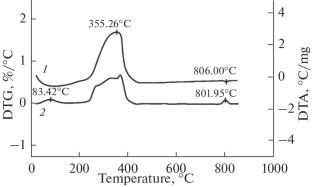钯纳米颗粒对PD@CF2催化剂形态和热稳定性的影响
IF 0.3
Q4 MATERIALS SCIENCE, MULTIDISCIPLINARY
引用次数: 0
摘要
研究了钯对硝基芳香族化合物加氢非均相催化剂Pd@CF2颗粒形貌和热稳定性的影响。结果表明,金属钯的存在改变了催化剂颗粒的形状和平均尺寸,使其在空气中加热时的热稳定性降低到180℃,并伴随氧化钯的形成。确定了氧化钯的热解离开始于800℃,结束于金属钯的形成。本文章由计算机程序翻译,如有差异,请以英文原文为准。

Effect of Palladium Nanoparticles on Morphology and Thermal Stability of PD@CF2 Catalyst
The effect of metallic palladium on the particle morphology and thermal stability of a promising heterogeneous catalyst Pd@CF2 for the hydrogenation of nitro-aromatic compounds is studied. It is shown that the presence of metallic palladium changes the shape and average size of the resulting catalyst particles and reduces its thermal stability to 180°C when heated in air, which is accompanied by the formation of palladium oxide. It is established that thermal dissociation of palladium oxide begins at 800°C and ends with the formation of metallic palladium.
求助全文
通过发布文献求助,成功后即可免费获取论文全文。
去求助
来源期刊

Inorganic Materials: Applied Research
Engineering-Engineering (all)
CiteScore
0.90
自引率
0.00%
发文量
199
期刊介绍:
Inorganic Materials: Applied Research contains translations of research articles devoted to applied aspects of inorganic materials. Best articles are selected from four Russian periodicals: Materialovedenie, Perspektivnye Materialy, Fizika i Khimiya Obrabotki Materialov, and Voprosy Materialovedeniya and translated into English. The journal reports recent achievements in materials science: physical and chemical bases of materials science; effects of synergism in composite materials; computer simulations; creation of new materials (including carbon-based materials and ceramics, semiconductors, superconductors, composite materials, polymers, materials for nuclear engineering, materials for aircraft and space engineering, materials for quantum electronics, materials for electronics and optoelectronics, materials for nuclear and thermonuclear power engineering, radiation-hardened materials, materials for use in medicine, etc.); analytical techniques; structure–property relationships; nanostructures and nanotechnologies; advanced technologies; use of hydrogen in structural materials; and economic and environmental issues. The journal also considers engineering issues of materials processing with plasma, high-gradient crystallization, laser technology, and ultrasonic technology. Currently the journal does not accept direct submissions, but submissions to one of the source journals is possible.
 求助内容:
求助内容: 应助结果提醒方式:
应助结果提醒方式:


